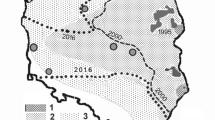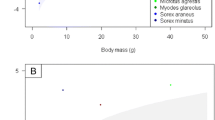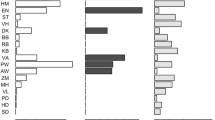Abstract
A total of 3,235 Dermacentor variabilis (Say) specimens were collected from birds, mammals, and by dragging vegetation, and 2,683 D. albipictus (Packard) ticks were collected from deer from 1993 to 1996. Peak seasonal occurrence of adult D. variabilis was from May through July with a precipitous decrease in August. Nymphal D. variabilis populations peaked in June. Peak activity of larvae was bimodal, with one activity peak during late summer (September) and a second peak in winter or early spring. The raccoon, Procyon lotor (L.), was the principal host of adults followed by the Virginia opossum, Didelphis virginiana Kerr. Rodents and the eastern cottontail rabbit, Sylvilagus floridanus (J. A. Allen), were the primary hosts of nymphs. The marsh rice rat, Oryzomys palustris (Harlan), was the principal host of larvae followed by the pine vole, Microtus pinetorum (Le Conte), and white-footed mouse, Peromyscus leucopus (Rafinesque). All stages of D. albipictus were found only on white-tailed deer, Odocoileus virginianus (Zimmermann). Numbers of adult and nymphal D. albipictus peaked in November, whereas larvae peaked in September.
Similar content being viewed by others
References
Bequaert, J.C. 1945. The ticks, or Ixodoidea, of the northeastern United States and eastern Canada. Entomol. Americana 25: 73–232.
Brillhart, D.B., Fox, L.B. and Upton, S.J. 1994. Ticks (Acari: Ixodidae) collected from small and medium-sized Kansas mammals. J. Med. Entomol. 31: 500–504.
Bishopp, F. and Trembley, H.L. 1945. Distribution and hosts of certain North American ticks. J. Parasitol. 31: 1–54.
Burgdorfer,W. 1975. A review of Rocky Mountain spotted fever (tick-borne typhus), its agent, and its tick vectors in the United States. J. Med. Entomol. 12: 269–278.
Bush A.O., Lafferty, K.D., Lotz, J.M. and Shostak, A.W. 1997. Parasitology meets ecology on its own terms: Margolis et al. revisited. J. Parasitol. 83: 575–583.
Campbell, A. and MacKay, D.P.R. 1979. Distribution of the American dog tick, Dermacentor variabilis (Say), and its small-mammal hosts in relation to vegetation types in a study area in Nova Scotia. Can. J. Zool. 57: 1950–1959.
Cooney, J.D. and Burgdorfer, W. 1974. Zoonotic potential (Rocky Mountain spotted fever and tularemia) in the Tennessee Valley region. Am. J. Trop. Med. Hyg. 23: 99–108.
Drummond, R.O. 1967. Seasonal activity of ticks (Acarina: Metastigmata) on cattle in southwestern Texas. Ann. Entomol. Soc. Am. 60: 439–447.
Fish, D. and Dowler, R.C. 1989. Host associations of ticks (Acari: Ixodidae) parasitizing medium-sized mammals in a Lyme disease endemic area of southern New York. J. Med. Entomol. 26: 200–209.
Gage, K.L., Burgdorfer, W. and Hopla, C.E. 1990. Hispid cotton rats (Sigmodon hispidus) as a source for infecting immature Dermacentor variabilis (Acari: Ixodidae) with Rickettsia rickettsii. J. Med. Entomol. 27: 615–619.
Hopla, C.E. and Hopla, A.K. 1994. Tularemia. In: Handbook of Zoonoses, 2nd ed., Section A: Bacterial, rickettsial, and mycotic zoonoses, G. W. Beran (ed.), pp. 113–126, CRC Press, Boca Raton, Florida.
Kollars, T.M., Jr. 1993. Ticks infesting medium-sized wild mammals in southwestern Tennessee. J. Med. Entomol. 30: 896–900.
Kollars, T.M., Jr. 1996. Interspecific differences between small mammals as hosts of immature Dermacentor variabilis (Acari: Ixodidae) and a model for detection of high risk areas of Rocky Mountain spotted fever. J. Parasitol. 82: 707–710.
Kollars, T.M., Jr., Durden, L.A., Masters, E. and Oliver, J.H., Jr. 1997. Some factors affecting infestation of white-tailed deer by blacklegged ticks, Ixodes scapularis, and winter ticks, Dermacentor albipictus (Acari: Ixodidae) in southeastern Missouri. J. Med. Entomol. 34: 372–375.
Kollars, T.M., Jr. and Ladine, T.A. 1999. Patterns of infestation by Dermacentor variabilis (Acari: Ixodidae) in a mark-recapture study of raccoons Procyon lotor (Mammalia: Carnivora) and Virginia opossums Didelphis virginiana (Mammalia: Didelphimorphia) in Tennessee. J. Med. Entomol. 36: 1–5.
Lavender, D.R. and Oliver, J.H., Jr. 1996. Ticks (Acari: Ixodidae) in Bulloch County, Georgia. J. Med. Entomol. 33: 224–231.
McEnroe,W. E. 1974. The regulation of adult American dog tick, Dermacentor variabilis Say, seasonal activity and breeding potential (Ixodidae: Acarina). Acarologia 16: 651–653.
Rogers, A.J. 1953. A study of the ixodid ticks of northern Florida, including the biology and life history of Ixodes scapularis Say (Ixodidae: Acarina). Ph.D. dissertation, University of Maryland, College Park.
Pung, O.J., Durden, L.A., Banks, C.W. and Jones, D.N. 1994. Ectoparasites of opossums and raccoons in southeastern Georgia. J. Med. Entomol. 31: 915–919.
Smart, D.L. and Caccamise, D.F. 1988. Population dynamics of the American dog tick (Acari: Ixodidae) in relation to small mammal hosts. J. Med. Entomol. 25: 515–522.
Sonenshine, D.E. 1972. The ecology of the American dog tick, Dermacentor variabilis, in a study area in Virginia. 1. Studies on population dynamics using radioecological methods. Ann. Entomol. Soc. Am. 65: 1164–1175.
Sonenshine, D.E. 1973. Ecology of the American dog tick, Dermacentor variabilis, in a study area in Virginia. 3. Studies on dispersal of immature ticks by small-mammal hosts. Ann. Entomol. Soc. Am. 66: 44–46.
Sonenshine, D.E. 1975. Influence of host-parasite interactions on the population dynamics of ticks. Misc. Publ. Entomol. Soc. Am. 9: 243–249.
Sonenshine, D.E. 1979. Ticks of Virginia (Acari: Mesastigmata). The insects of Virginia: No. 13. Virginia Polytechnic Institute and State University Research Bulletin 139, Research Division, Virginia Polytechnic Institute and State University, 42 p., Blacksburg, Virginia.
Sonenshine, D.E. 1993. Biology of ticks. Vol. 2, 465 pp., Oxford University Press, New York.
Sonenshine, D.E., Atwood, E.L. and Lamb, J.T. 1966. The ecology of ticks transmitting Rocky Mountain spotted fever in a study area in Virginia. Ann. Entomol. Soc. Am. 59: 1234–1262.
Sonenshine, D.E. and Stout, I.J. 1971. Ticks infesting medium sized mammals in two forest localities in Virginia (Acarina: Ixodidae). J. Med. Entomol. 8: 217–227.
Spach, D.H., Liles, W.C., Campbell, G.L., Quick, R.E., Anderson, D.E. and Fritsche, T.R. 1993. Tickborne diseases in the United States. N. Eng. J. Med. 329: 936–947.
Stiller, D., Leatch, G. and Kuttler, K. 1981. Experimental transmission of bovine anaplasmosis by the winter tick, Dermacentor albipictus (Packard). In: Proceedings of the Seventh National Anaplasmosis Conference, Mississippi State Univ., Mississippi State, Miss, pp. 463–475.
Stout, I.J. 1979. Ecology of spotted fever ticks in eastern Washington, In: Recent Advances in Acarology, J.G. Rodriguez (ed.), Vol. 2, pp. 113–122. Academic Press, New York.
Strickland, R.K., Gerrish, R.R., Hourigan, J.L. and Schubert, G.O. 1976. Ticks of veterinary importance. APHIS-USDA Agric. Handb. 485.
Zimmerman, R.H., McWherter, G.R. and Bloemer, S.R. 1987. Role of small mammals in population dynamics and dissemination of Amblyomma americanum and Dermacentor variabilis (Acari: Ixodidae) at Land Between the Lakes, Tennessee. J. Med. Entomol. 24: 370–375.
Author information
Authors and Affiliations
Rights and permissions
About this article
Cite this article
Kollars, T.M., Oliver, J.H., Masters, E.J. et al. Host utilization and seasonal occurrence of Dermacentor. Exp Appl Acarol 24, 631–643 (2000). https://doi.org/10.1023/A:1026566301325
Issue Date:
DOI: https://doi.org/10.1023/A:1026566301325




